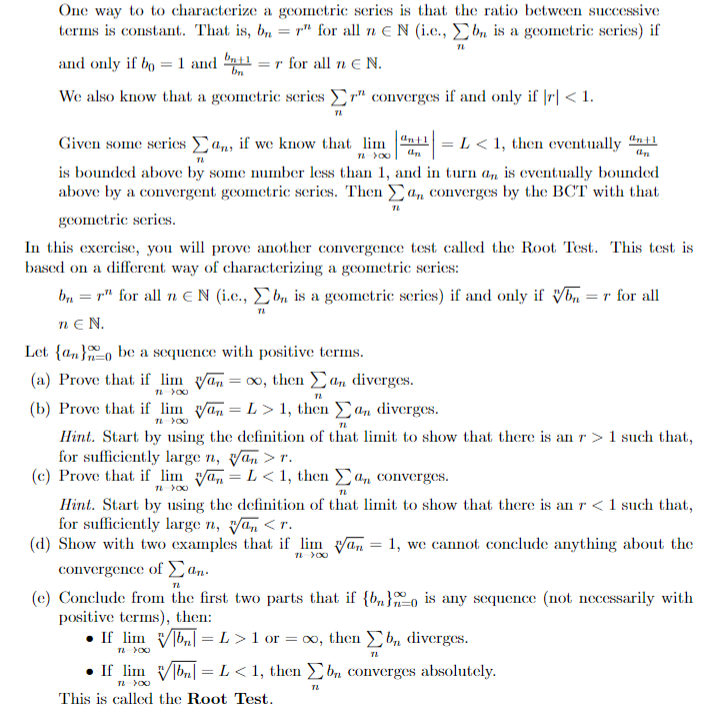Let {an}o be a sequence with positive terms. (a) Prove that if lim van= ∞, then La, diverges. (b) Prove that if lim van= L> 1, then Can diverges. Hint. Start by using the definition of that limit to show that there is an r > 1 such that, for sufficiently large n, Van >r. (c) Prove that if lim yan= L< 1, then Ca, converges. %3D
Let {an}o be a sequence with positive terms. (a) Prove that if lim van= ∞, then La, diverges. (b) Prove that if lim van= L> 1, then Can diverges. Hint. Start by using the definition of that limit to show that there is an r > 1 such that, for sufficiently large n, Van >r. (c) Prove that if lim yan= L< 1, then Ca, converges. %3D
Chapter9: Sequences, Probability And Counting Theory
Section: Chapter Questions
Problem 25RE: Use the formula for the sum of the first nterms of a geometric series to find S9 , for the series...
Related questions
Question

Transcribed Image Text:One way to to characterize a geometric series is that the ratio between successive
terms is constant. That is, b, = r" for all n EN (i.e., E bn is a goometric series) if
and only if bo =1 and nil
= r for all n E N.
bn
We also know that a geometric series r" converges if and only if |r| < 1.
Given some series an, if we know that lim "nt1 = L < 1, then eventually
is bounded above by some number less than 1, and in turn a, is eventually bounded
above by a convergent geometric scries. Then a,n converges by the BCT with that
gcometric scries.
In this exercise, you will prove another convergence test called the Root Test. This test is
based on a different way of characterizing a geometric series:
bn = r" for all n EN (i.c., E bn is a geometric series) if and only if Vn =r for all
nɛ N.
Let {an}o be a sequence with positive terms.
(a) Prove that if lim van = 0, then Ca, diverges.
(b) Prove that if lim van = L> 1, then an diverges.
Hint. Start by using the definition of that limit to show that there is an r >1 such that,
for sufficiently large n, van > r.
(c) Prove that if lim ya, = L< 1, then (a, converges.
Hint. Start by using the definition of that limit to show that there is an r <1 such that,
for sufficiently large n, yan <r.
(d) Show with two examples that if lim yan = 1, we cannot conclude anything about the
convergence of Ean.
(e) Conclude from the first two parts that if {b„}o is any sequence (not necessarily with
positive terms), then:
• If lim Vb = L > 1 or = xo, then b, diverges.
• If lim Vbn = L< 1, then £b, converges absolutely.
This is called the Root Test.
Expert Solution
This question has been solved!
Explore an expertly crafted, step-by-step solution for a thorough understanding of key concepts.
Step by step
Solved in 4 steps with 3 images

Recommended textbooks for you


Algebra & Trigonometry with Analytic Geometry
Algebra
ISBN:
9781133382119
Author:
Swokowski
Publisher:
Cengage


Algebra & Trigonometry with Analytic Geometry
Algebra
ISBN:
9781133382119
Author:
Swokowski
Publisher:
Cengage